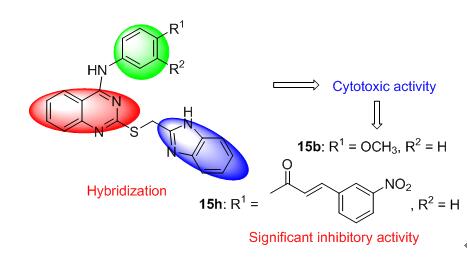| [1] Siegel, R. L.; Fedewa, S. A.; Miller, K. D.; Goding-Sauer, A.; Pinheiro, P. S.; Martinez-Tyson, D.; Jemal, A. Ca-Cancer J. Clin. 2015, 65, 457.
[2] Jemal, A.; Siegel, R.; Ward, E.; Murray, T.; Xu, J.; Thun, M. J. Ca-Cancer J. Clin. 2007, 57, 43.
[3] Creixell, M.; Peppas, N. A. Nano Today 2012, 7, 367.
[4] Loomis, D.; Huang, W.; Chen, G. Chin. J. Cancer 2014, 34, 189.
[5] Yang, S.; Li; Z.; Jin, L. H.; Song, B. A.; Liu, G.; Chen, J.; Chen, Z.; Hu, D. Y.; Xue, W.; Xu, R. Q. Bioorg. Med. Chem. Lett. 2007, 17, 2193.
[6] Zhang, H. Z.; Damu, Guri, L. V.; Cai, G. X.; Zhou, C. H. Eur. J. Med. Chem. 2013, 64, 329.
[7] Janmaat, N. L.; Giaccone, G. Oncologist 2003, 576.
[8] He, J. B.; Wang, X. G.; Zhao, X. Q; Liang, Y. J.; He, H. W.; Fu, L. W. Eur. J. Med. Chem. 2012, 54, 925.
[9] Chao, B.; Li, B. X.; Xiao, X. Bioorg. Med. Chem. Lett. 2017, 27, 3107.
[10] Khurana, L.; Ali, H. I.; Olszewska, T.; Ahn, K. H.; Damaraju, A.; Kendall, D. A.; Lu, D. J. Med. Chem. 2014, 57, 3070.
[11] Cui, M. T.; Jiang, L.; Goto, M.; Hsu, P. L.; Li, L. N.; Zhang, Q.; Wei, L.; Yuan, S. J.; Hamel, E.; Morris-Natschke, S. L. J.Med. Chem. 2017, 60, 5586.
[12] Wu, J. Z.; Li, J. L.; Cai, Y. P.; Pan, Y.; Ye, F. Q.; Zhang, Y. L.; Zhao, Y. J.; Yang, S. L.; Li, X. K.; Liang, G. . Med. Chem. 2011, 54, 8110.
[13] Wu, X. Q.; Li, M.; Tang, W. H.; Zheng, Y. G.; Lian, J. Q.; Xu, L.; Ji, M. Chem. Biol. Drug Design 2011, 78, 932.
[14] Refaat, H. M. Eur. J. Med. Chem. 2010, 45, 2949.
[15] Liu, F.; Huang, Y. Pestic. Biochem. Physiol. 2011, 101, 248.
[16] Raju, B.; Rao, R. N.; Suman, P.; Yogeeswari, P.; Sriram, D.; Shaik, T. B.; Kalivendi, S. V. Bioorg. Med. Chem. Lett. 2012, 22, 500.
[17] Pan, X. L.; Wang, L.; Dun, Y. Y..; Fang, H. Chin. J. Org. Chem. 2016, 36, 1044(in Chinese). (潘晓乐, 王磊, 顿艳艳, 方浩, 有机化学, 2016, 36, 1044.)
[18] Zhang, Y.; Lv, M. J..; Zhang, Y. L..; Chen, L.; Wang, W.; Li, B. L. Chin. J. Org. Chem. 2017, 37, 1787(in Chinese). (张颖, 吕梦娇, 张娅玲, 陈丽, 王伟, 李宝林, 有机化学, 2017, 37, 1787.)
[19] Yang, L. M.; Lin, S. J.; Hsu, F. L.; Yang, T. H. Bioorg. Med. Chem. 2002, 12, 1013.
[20] Sahay, I. I.; Ghalsasi, P. S. Synth. Commun. 2017, 47, 825.
[21] Chou, S.; Yin, W.; Chung, Y.; Chang, L.; Liu, C.; Chen, S.; Shih, K. Org. Process Res. Dev. 2002, 6, 273.
[22] Horowitz, D.; King, A. G. J. Immunol. Methods 2000, 244, 49.
[23] Putnam, K. P.; Bombick, D. W.; Doolittle, D. J. Toxicol. in Vitro 2002, 16, 599. |
